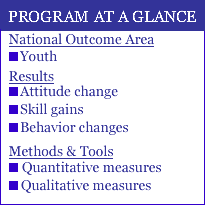
2001
Exemplary
Program
Evaluations
Exemplary
Program
Evaluations

| State: | Utah | |||
| Project name: | Youth and Families with Promise | |||
| Participants: | Youth and their families are referred from school administrators, Juvenile Courts, community and religious organizations or from parents | |||
| Number involved: | Approximately 500 students last year (in 22 counties) although only 381 students included in evaluation since they must be in the program for a minimum of 6 months for inclusion | |||
| Program: |
Two level mentoring program (young adult individual mentors and grandparent age couple or individual mentors). Mentors establish a relationship with the identified youth and their family through providing motivation and tutoring relating to reading and academic skills and also participating with them in structured recreation, community service, and 4-H. |
|||
| Young adult mentors use Connect curriculum developed based upon Search Institute's Developmental Assets for 1:1 work between youth and mentor. Grandmentors use Strengthening Families Ties curriculum with youth and families. | ||||
| Youth, parents, and mentors participate in monthly group activities using the Family Night Out program curriculum developed by Washington State Extension. | ||||
| Youth and mentors participate in service projects about every quarter. | ||||
| Where: | Program is implemented through the county Extension office, which houses the site coordinator. Actual programs take place at many places including schools. | |||
| When: | Program runs on a school year calendar. Mentors are supposed to meet with youth on a weekly basis and with the family on a monthly basis. | |||
| Who: |
|
Program is administered under the direction of Utah Sate University Extension with paid and volunteer staff in each county in collaboration with a local advisory board. | ||
| Young-adult mentors are recruited from students attending one of Utah's universities, colleges, or technical schools. Grandmentors are recruited from the family's religious congregation or from community volunteer organizations. | ||||
| Improve academic performance | ||||
| Increase interpersonal competence | ||||
| Strengthen family bonds | ||||
| Methods & Tools | |||||||||
| A retrospective pre- and posttest was developed for this project for parents, youth, and mentors | |||||||||
| Mentors complete a monthly report indicating how often they met with their mentee, what they did, and if they did focus on an asset, which one it was | |||||||||
| Instruments were developed for individual interviews with youth and for focus groups with parents, grandmentors, and young adult mentors | |||||||||
| Pre and post questionnaires (completed by youth, parents, and teachers) assesses youth's attitudes about school, interpersonal skills, family relationships, self-reported changes in academic skills, problem behaviors and healthy behaviors | |||||||||
| If parents do not complete the survey, site coordinator goes to their home to assist them in its completion | |||||||||
| Individual interviews with selected youth | |||||||||
| Focus group interviews with parents and mentors | |||||||||
| Analysis | |||||||||
| Paired t-tests to determine change between self-reports pre and post | |||||||||
| Based on mentor's monthly reporting, each mentee is either considered a "high" dosage or a "low" dosage group. Analyses are conducted on each separately | |||||||||
| Focus groups and individual interviews are entered into NUD*IST and themes are grouped and analyzed. | |||||||||
| Results | |||||||||
| High dosage group has shown statistically significant change in 20 out of the 21 variables | |||||||||
| Low dosage group has shown statistically significant change in 7 out of the 21 variables | |||||||||
| Focus group and individual interviews provide support for the quantitative findings while also providing more information on the process and meaning of the program for youth, parents, and mentors | |||||||||
| To assess program effectiveness | ||||
| Program planning | ||||
| Program modification | ||||
| Documentation in grant proposal writing | ||||
| Reports to collaborators and funders | ||||
| Marketing to potential funders | ||||
| Marketing to the community | ||||
| For support to replicate program in other places | ||||
| Tom
Lee Email: toml@ext.usu.edu |
|||
| Retrospective pre- and posttest for parents | ||||
| Retrospective pre- and posttest for youth | ||||
| Retrospective pre- and posttest for mentors | ||||
| Mentor monthly reporting form | ||||
| Interview questions for youth | ||||
| Focus group questions for parents | ||||
| Focus group questions for grandmentors | ||||
| Focus group questions for young adult mentors | ||||